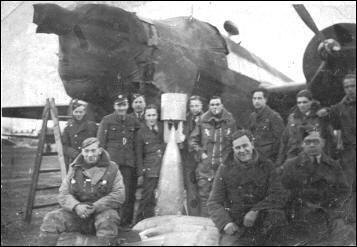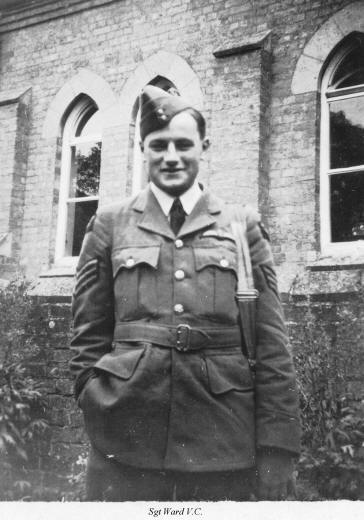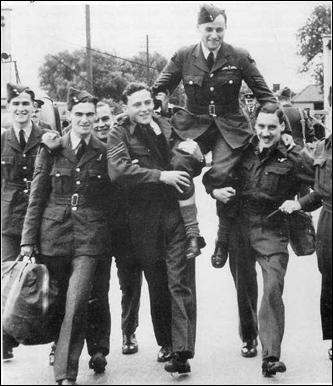| RAF Feltwell - Personnel - memorial pages. |
Photo pages -> |
|||||||
|
|
|
|
||||||
| Recollections | RAF Feltwell History | RAF Feltwell Planes & Buildings | 75 NZ Squadron |
|
|
|
|
|
For bomber command 1940 had been spent supporting the campaigns in Norway and France and bombing targets related to a potential German invasion of this country. Certainly some strategic bombing of the Reich had been conducted during that year but it was not until 1941 that the RAF was able to give its full attention to bombing Germany.
In 1941, the main foes of the RAF Bomber Command Squadrons at Feltwell, were the “Kammhuber” defences that protected the new German Reich. Flak batteries defended any vulnerable areas of enemy held coast along any line that would be taken by any British attacking bomber force. The best example was the City of Hamburg, a popular target with the RAF. The Flak concentration started on the Frisian Islands, far from the main target but at a point where the RAF bombers were likely to cross. The Kammhuber line, which extended along the whole of the Western coast of occupied Europe, included anti aircraft (Flak) defences, radar guided night fighters along the enemy coast and long range Ju88 intruders.
Me110 night fighters would shadow and attack the British bomber force as it was over the North Sea either on approach to or leaving a target. The most daring attacks were made well inland over East Anglia by the long range Ju88 night fighters of Nachtjagderswader I & II. These units would prowl the East Anglian coast waiting for RAF bombers to show up against good lighting conditions on the coastline. Often NJG II would venture inland and wait for the bombers at the most vulnerable moment, when they were approaching their own airfields. Although Feltwell never suffered an attack made directly over the village, Marham and Beck Row were not as lucky. Uffz Alfons Koster, a very experienced pilot with NJG II, shot down a Wellington near both of these villages just as they were preparing to land. The Wellington that he shot down at Beck Row crashed on top of a house occupied by Mrs Rene Titmarsh, (nee Wortley), who came from Methwold Hythe.
General Joseph Kammhuber is credited with devising the strategy and layout of the German defences against the allied bomber force.
Sgt WF “Chappie” Chapman, seen below, served at Feltwell and Methwold for most of 1941. He started his tour of operations with No. 75 (NZ) Squadron but was soon moved to the newly formed 57 Squadron. He initially lived in the billets at Feltwell where he shared a room with Sgt J. Ward, VC, but later found lodgings in the village.
 “We
did Hamburg on three out of four consecutive nights”, he said as we talked about
his time at Feltwell. “On one of the trips we were gaining height as we headed
out towards the coast near the Wash, which was our turning point for the track
up to Frisian Islands. Minutes after we had crossed the coast my rear gunner,
Jock, called me up over the intercom and told me that a fighter had latched on
to us on the port quarter. A few cannon shells whistled past us so I put the
aircraft into a very steep dive in an attempt to make him break off the attack.
I soon noticed that the air speed indicator was registering off the scale as the
fully loaded wimpy gained momentum. I called up the crew and told them to yell
as loud as they could when I started to pull out to stop them blacking out. I
managed to pull out of the dive all right but I found that I could only fly the
aircraft with the trim tabs set fully back. The aircraft flew like this ok so
we did our raid and made it back to Feltwell.
“We
did Hamburg on three out of four consecutive nights”, he said as we talked about
his time at Feltwell. “On one of the trips we were gaining height as we headed
out towards the coast near the Wash, which was our turning point for the track
up to Frisian Islands. Minutes after we had crossed the coast my rear gunner,
Jock, called me up over the intercom and told me that a fighter had latched on
to us on the port quarter. A few cannon shells whistled past us so I put the
aircraft into a very steep dive in an attempt to make him break off the attack.
I soon noticed that the air speed indicator was registering off the scale as the
fully loaded wimpy gained momentum. I called up the crew and told them to yell
as loud as they could when I started to pull out to stop them blacking out. I
managed to pull out of the dive all right but I found that I could only fly the
aircraft with the trim tabs set fully back. The aircraft flew like this ok so
we did our raid and made it back to Feltwell.
The next day I told our groundcrew “Chiefy” what I had done. He asked me what speed I might have been doing, so I said maybe around 500 MPH. Later on Chiefy jigged up the aircraft and found that I had bent both wing tips back by about 6 inches. That must have taken a lot of force but the Wimpy had handled it all right. They really were tough old kites”
“Chappie” was a good pilot but I think he knows that he was extremely lucky to escape this attack. He goes on to talk about his old roommate and his encounter with a Me110 night fighter on the night of 7th/8th July 1941.
Below. "Chappie" Chapman and Crew
 “In
those days I was supposed to live on the Station at Feltwell but I was a married
man, (my wife came from Dagenham), and we wanted to be together. It was
difficult to get any sort of accommodation around Feltwell but eventually a
local farmer, Mr Lawrence, who had a farm on the Methwold Road took us in. We
lived in the large bedroom in his house at Murials Farm. The Lawrence’s did not
have any children of their own and they were very kind to us. Food was a bit
short in those days so I became a dab hand with a shotgun and often potted a
rabbit or pheasant for our meals. My roommate at Feltwell was Sgt Jimmy Ward
who was to become the first New Zealander VC winner of the war. Jimmy loved me
living off the Station in that he had a great big room all to himself!
“In
those days I was supposed to live on the Station at Feltwell but I was a married
man, (my wife came from Dagenham), and we wanted to be together. It was
difficult to get any sort of accommodation around Feltwell but eventually a
local farmer, Mr Lawrence, who had a farm on the Methwold Road took us in. We
lived in the large bedroom in his house at Murials Farm. The Lawrence’s did not
have any children of their own and they were very kind to us. Food was a bit
short in those days so I became a dab hand with a shotgun and often potted a
rabbit or pheasant for our meals. My roommate at Feltwell was Sgt Jimmy Ward
who was to become the first New Zealander VC winner of the war. Jimmy loved me
living off the Station in that he had a great big room all to himself!
He was a quiet sort of chap and I believe he had been a schoolteacher before he joined up. He was always borrowing my old BSA Blue Star motorbike.
A lot of things have been written about Jimmy Ward winning the VC, many of them are very inaccurate. I can only tell you what he told me at the time. He had been crewed up as second pilot to Squadron leader Widdowson (this was to do his four trips before he became captain). They were flying at about 15000 feet when they were attacked by a German Me 110 over the Zuider Zee. The rear gunner returned fire on the fighter and shot it down, but the aircraft was badly damaged and a fire started in the wing behind the starboard engine. On the small fold up bed in the aircraft were a couple of old engine covers. Jimmy took the rope off these and tied it around his waist; the idea was that he would go out of the Astrodome with one of the crew hanging on to the other end of the rope. His skipper told him that he must wear his parachute in case he was swept off the wing. Jimmy said that it was pointless as it would increase the drag on his body and, as they were flying over the sea, he would die anyway! But his skipper persisted so Jimmy clipped on his chest parachute and tried to get out of the Astrodome, but he found that he could not get through with the parachute on.
 Left. Jimmy Ward VC
Left. Jimmy Ward VC
This time his skipper was ahead of him in the argument and told him to push his parachute out of the astrodome and climb out and put it on. That is what he did. He used the aircraft’s fire axe to cut footholds in the wing and whilst his skipper cut the airspeed down to about 80 knots he tried to smother the fire with one of the old engine covers.
After Jimmy was awarded the VC he was taken off operations for three weeks so that he could go to Buckingham Palace to collect his medal. After this we would go to the Sergeants mess at Feltwell and as soon as Jimmy walked in everyone would stand up and salute. Whenever this happened Jimmy would do a quick 180 degrees and walk out, he was very shy about the whole thing. But this meant that we were both living on sandwiches, so I had a word with the lads and they packed it in.
 Right.
Jimmy Ward and friends at Lakenheath Railway Station
Right.
Jimmy Ward and friends at Lakenheath Railway Station
At the end of the three weeks Jimmy became captain of his own aircraft; on his first trip as captain they had some trouble and landed away from Feltwell.
On 15th September, when he was on his second trip, (Hamburg), he was shot down over the target and killed”.
When Sgt Ward was awarded his VC he had been flying as second Pilot with Squadron Leader R.P. Widdowson (who was awarded a DFC on the same day). Sq./Ldr Widdowson was no stranger to the effects of a night fighter attack as he had also been attacked two months earlier. On the night of 11th May he was crossing the coast at Cromer outward bound for Hamburg when he was picked up by a Ju88.
Attacking intruders would often attempt to take out the Wellingtons rear gun turret as it dramatically reduced its firepower. On the night of the 11th May 1941 his rear gunner was Sgt Eric Gannaway, (aged 21) who lived at the Vicarage at Hockwold. The following account of the attack was given by Sgt L.A. (Joe) Lawson the aircraft navigator.
 “Our
rear gunner Sgt Gannaway, seen below, from Hawke’s Bay, New Zealand was killed
by a Ju88. Our aircraft was attacked from dead astern and the fighter must have
seen us against the lighter sky. An armour piercing 20mm cannon shell went
right through him. Tony Saunders the second pilot and myself went back to pull
him out of the rear turret. We gave him morphine to deaden the pain and then
tried to operate the turret but it was U/S. We aborted the mission and returned
to Feltwell. Gannaway didn’t realise how badly injured he was and died shortly
after we landed. He was buried in Feltwell cemetery and the funeral took the
usual format – a slow march to the cemetery and after the burial the band
striking up “Colonel Bogie” as we marched away.
“Our
rear gunner Sgt Gannaway, seen below, from Hawke’s Bay, New Zealand was killed
by a Ju88. Our aircraft was attacked from dead astern and the fighter must have
seen us against the lighter sky. An armour piercing 20mm cannon shell went
right through him. Tony Saunders the second pilot and myself went back to pull
him out of the rear turret. We gave him morphine to deaden the pain and then
tried to operate the turret but it was U/S. We aborted the mission and returned
to Feltwell. Gannaway didn’t realise how badly injured he was and died shortly
after we landed. He was buried in Feltwell cemetery and the funeral took the
usual format – a slow march to the cemetery and after the burial the band
striking up “Colonel Bogie” as we marched away.
The attack that killed Pete Gannaway had been a typical German night fighter interception. As most of these attacks happened some distance from Feltwell the RAF groundcrew and people in the village were unaware of their nature. However, sometimes aircraft made it back to the Station and the full extent of war became apparent.
On the night of 15/16 July the target for 75 Squadron was the town of Duisburg. Wellington W5663, Piloted by Pilot Officer William Rees was sent out as part of the attacking force. Whilst the aircraft was over the target it was struck by Flak and shortly afterwards attacked by a German night fighter. Cannon shells burst through the front of the aircraft killing Sgt David Joyce the second pilot and mortally wounding Sgt David Conibear the front gunner. Pilot Officer R. Hunter, the aircraft’s navigator, left his position to help Sgt Conibear and Sgt Gwyn-Williams, the rear gunner who had also been injured. Unknown to any of the crew the fighter attack had blown open the aircraft’s mid-under hatch and P/O Hunter fell through it. The pilot returned to Feltwell with the assistance of Sgt Ivan Lewis, the aircraft’s wireless operator, the only other person who was uninjured. Unfortunately blood from the injured men had leaked out of the aircraft via the open hatchway and was carried along the fuselage by the aircraft’s slipstream. As a result the fuselage was heavily bloodstained when it landed back at the Station. David Conibear died of his injuries the following day. Pilot Officer Rees was awarded the Distinguished Flying Cross and Sgt Lewis the Distinguished Flying Medal. Later in the war, whilst doing his second tour with No. 195 Squadron, Rees brought another bomber back safely, with two engines shot out and wounded crew on board. He was subsequently awarded a bar to his DFC and promoted to Squadron Leader.
The bloodstained Wellington was repaired and stayed in service with 75 Squadron. It was eventually shot down on a 16th October near Dusseldorf with Sgt R.C. Barker as captain. It was a bad night for the Feltwell Squadrons, the target was Cologne and 16 airmen were killed when three Feltwell based bombers were shot down.
The German fighters continued to take a heavy toll on the aircraft based at Feltwell. They would reign supreme until as late as 1944 when the attrition faced by the Luftwaffe on the Eastern Front and the introduction of the P-51 Mustang on the Western Front decimated the force. It was to be a different war and changed circumstances that were to bring the German pilots to Feltwell 11 years after the war had ended.
General Joseph Kammhuber, whose cunning Reich defence strategy had accounted for most of Feltwell’s combat bomber losses during the war, was captured in 1945. He spent the next 2½ years in an American prison. On 1st June 1956 he became a Lt General and the commander of section VI of the Federal Defence Ministry. He had spent six years of the war as the British bomber pilots most feared enemy but as a post-war General he became one of their closest allies.
The loss rate for Bomber Command had risen to 4.8% of the attacking force during 1941, (excluding losses due to flying accidents). 57Sq. and 75Sq. stationed at Feltwell had lost over 230 airmen killed in combat over that year. It is easy to forget that most of them were very young.
“Chappie” Chapman was aged 20 when he served here; Sgt James Ward and Sgt Eric Gannaway were both age 21. Watching Sgt Ward on the old Pathe newsreel about his VC he is clearly embarrassed by all of the fuss and publicity. He says, “I didn’t expect all this when I left New Zealand, a short time ago” and constantly smiles.
In hindsight Fate seems to have played a cruel trick on the Bomber crews. General Kammhuber had been shot down and captured on 3rd June 1940 whilst making an attack on Paris as Kommodore of KG51. Later he was released under the terms of the French/German armistice signed on 21st June. It is tempting to wonder what may have happened if the French Government had had the courage to transfer him and the other captured Luftwaffe pilots to Britain before the armistice was signed. Perhaps things might have gone quite differently.
Photographs of Chappie Chapman and his crew were kindly provided by Mr Chapman himself.
Photographs of Sgt James Ward VC were kindly provided by Mr Red McCowatt, 75 Squadron Association.
A short film taken at the time Sgt James Ward received his VC can be found on www.britishpathe.com by keying in Wellington Bomber.